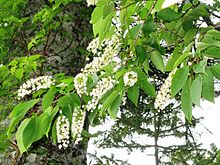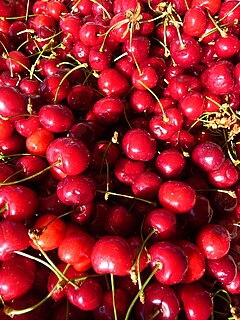
A cherry is the fruit of many plants of the genus Prunus, and is a fleshy drupe.

A plum is a fruit of some species in Prunus subg. Prunus. Mature plum fruits may have a dusty-white waxy coating that gives them a glaucous appearance. This is an epicuticular wax coating and is known as "wax bloom". Dried plums are called prunes, which have a dark, wrinkled appearance.

Sakhalin is the largest island of Russia. It is the northernmost island of the Japanese archipelago, and is administered as part of the Sakhalin Oblast. Sakhalin is situated in the Pacific Ocean, sandwiched between the Sea of Okhotsk to the east and the Sea of Japan to the west. Sakhalin is located just off Khabarovsk Krai, and is north of Hokkaido in Japan. The island houses a population of roughly 500,000, the majority of which are Russians.

The Kuril Islands or Kurile Islands is a volcanic archipelago part of Sakhalin Oblast in the Russian Far East. It stretches approximately 1,300 km (810 mi) northeast from Hokkaido in Japan to Kamchatka Peninsula in Russia separating the Sea of Okhotsk from the north Pacific Ocean. There are 56 islands and many minor rocks. The Kuril Islands consist of the Greater Kuril Chain and the Lesser Kuril Chain. They cover an area of around 10,503.2 square kilometres (4,055.3 sq mi), with a population of roughly 20,000.

A cherry blossom is a flower of many trees of genus Prunus or Prunus subg. Cerasus. They are also known as Japanese cherry and Sakura. They generally refer to ornamental cherry trees, not to be confused with cherry trees that produce fruit for eating. It is considered the national flower of Japan.

Prunus laurocerasus, also known as cherry laurel, common laurel and sometimes English laurel in North America, is an evergreen species of cherry (Prunus), native to regions bordering the Black Sea in southwestern Asia and southeastern Europe, from Albania and Bulgaria east through Turkey to the Caucasus Mountains and northern Iran.

Prunus subg. Padus is a subgenus of Prunus, characterised by having racemose inflorescences. Padus was originally a distinct genus, but genetic and morphological studies have shown that Padus is polyphyletic. It has been proposed that all the racemose taxons within Prunus are incorporated into a broad-sense Prunus subg. Padus. However, this broad-sense Prunus subg. Padus is not monophyletic either. Therefore, better infrageneric classification is needed for the racemose species in Prunus.

Prunus padus, known as bird cherry, hackberry, hagberry, or Mayday tree, is a flowering plant in the rose family. It is a species of cherry, a deciduous small tree or large shrub up to 16 metres (52 ft) tall. It is the type species of the subgenus Padus, which have flowers in racemes. It is native to northern Europe and northern and northeast Asia, and is grown as an ornamental in North America.

Prunus serotina, commonly called black cherry, wild black cherry, rum cherry, or mountain black cherry, is a deciduous tree or shrub of the genus Prunus. Despite being called black cherry, it is not very closely related to the commonly cultivated cherries such as sweet cherry, sour cherry and Japanese flowering cherries which belong to Prunus subg. Cerasus. Instead, P. serotina belongs to Prunus subg. Padus, a subgenus also including Eurasian bird cherry and chokecherry. The species is widespread and common in North America and South America.

Prunus grayana is a species of bird cherry native to Japan and China, occurring at medium altitudes of 1,000–3,800 m in the temperate zone. It prefers sunshine and moist soil.

Prunus prostrata is a hardy alpine shrub found naturally above about 2000 m. up to as high as 4000 m. in Israel, Algeria, Morocco, Tunisia, Syria, Turkey, Albania, Greece, Sardinia, Croatia. It grows as tall as 1 m., more typically 0.15-0.30 m., sometimes in the crevices of vertical surfaces. The branches tend to follow the surface at any angle. Flowering patches of the plant on the rocky slopes, sometimes still snow-clad, are striking to climbers.

Prunus sargentii, commonly known as Sargent's cherry or North Japanese hill cherry, is a species of cherry native to Japan, Korea, and Sakhalin (Russia).
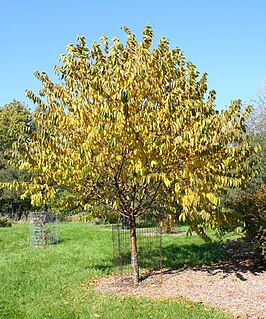
Prunus maximowiczii, known as Korean cherry, Korean mountain cherry, or Miyama cherry, is a small, fruiting cherry tree that can be found growing wild in northeastern Asia and Eurasia.
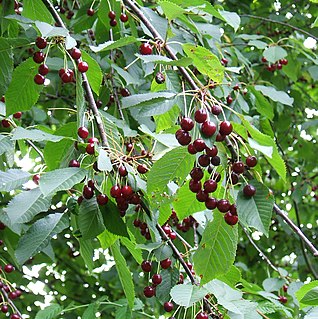
Prunus avium, commonly called wild cherry, sweet cherry, gean, or bird cherry is a species of cherry, a flowering plant in the rose family, Rosaceae. It is native to Europe, Anatolia, Maghreb, and Western Asia, from the British Isles south to Morocco and Tunisia, north to the Trondheimsfjord region in Norway and east to the Caucasus and northern Iran, with a small isolated population in the western Himalaya. The species is widely cultivated in other regions and has become naturalized in North America and Australia.
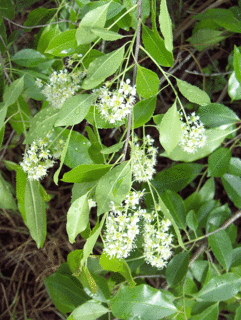
Prunus caroliniana, known as the Carolina laurelcherry, Carolina cherry laurel, cherry laurel, or Carolina cherry, is a small evergreen flowering tree native to the lowlands of Southeastern United States, from North Carolina south to Florida and westward to central Texas. The species has also escaped into the wild in a few places in California.

Prunus pseudocerasus or Prunus pseudo-cerasus, the Chinese sour cherry or just Chinese cherry, is a species of cherry native to China and is used worldwide as an ornamental for its early spring cherry blossoms. The fruits of some cultivars are edible.

Prunus buergeriana, in Japanese イヌザクラ (inu-zakura), meaning dog cherry, is a species of bird cherry native to Japan, Korea, Taiwan, China, northeast India (Sikkim), and Bhutan. In China it prefers to grow on mountain slopes at 1000 to 3400 m above sea level. Its closest relative is Prunus perulata, from which it is morphologically and genetically distinct.
Prunus cornuta, the Himalayan bird cherry, is a species of bird cherry native to the foothills of the Himalayas, including China and the countries of the Indian subcontinent. A medium-sized tree, it can reach 18 m. It is used for a rootstock for sweet cherries in India. Its specific epithet references the "horned" deformation of the fruit seen when a tree is afflicted with the fungal disease pocket plum gall, ascribed to the species Taphrina padi.
Prunus rufa, called Himalayan cherry, is a species of cherry native to Nepal and Burma. It is used as an ornamental elsewhere for its striking shiny brown bark. It has been found growing at 3,925 m (12,900 ft) above sea level in the Himalayas.
Prunus napaulensis is a species of bird cherry native to the eastern foothills of the Himalayas, including Nepal, Myanmar and China. A tree, it can reach 27 m and prefers to grow between 1800 and 3000 m above sea level. The fruit is edible, and it is cultivated for its fruit in Assam and Ukhrul District, Manipur. It is called Theikanthei in Tangkhul language.(and presumably elsewhere). Its wood is used locally for making furniture. It goes by many common names across its range, including jangali aru and arupate (Nepalese), arupaty (Bengali), sohiong (Khasi), sajong (Assamese) and 粗梗稠李 "crude stalk thick plum" (Chinese). Prunus bracteopadus is a very similar species, possibly conspecific.
